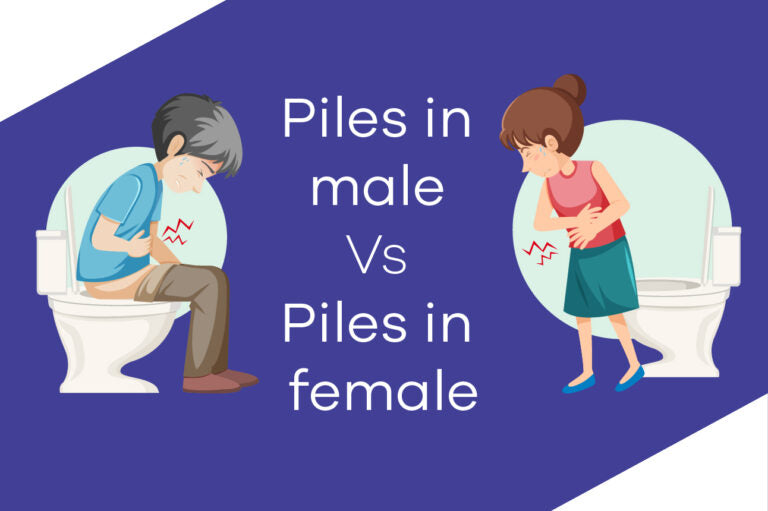Hemorrhoids are a common and often uncomfortable condition that affects both men and women. While the symptoms and treatments are generally similar, there are subtle differences in how hemorrhoids manifest and impact each gender. This blog will delve into these differences, exploring the causes, symptoms, and treatment options for male and female hemorrhoids. By understanding these distinctions, you can better manage and prevent this condition.
What Are Hemorrhoids?
Hemorrhoids, also known as piles, are swollen veins in the lower rectum and anus. They can be internal, located inside the rectum, or external, under the skin around the anus. Hemorrhoids are common and can result from various factors such as straining during bowel movements, chronic constipation, prolonged sitting, and pregnancy.
Common Causes of Hemorrhoids
Male-Specific Causes
- Heavy Lifting: Men are often involved in jobs or activities that require heavy lifting, which can increase abdominal pressure and lead to hemorrhoids.
- Prolonged Sitting: Many men work in professions that involve long hours of sitting, such as truck driving or office jobs, which can contribute to the development of hemorrhoids.
- Diet and Lifestyle: Men might consume diets low in fiber and high in processed foods, leading to constipation and straining during bowel movements.
Female-Specific Causes
- Pregnancy: Pregnancy significantly increases the risk of hemorrhoids in women. The growing uterus puts pressure on the pelvic veins, and hormonal changes can cause veins to swell.
- Childbirth: The process of childbirth, particularly vaginal delivery, can strain the anal region and lead to hemorrhoids.
- Hormonal Changes: Menstrual cycles and hormonal fluctuations can affect bowel habits and increase the risk of hemorrhoids.
Symptoms of Hemorrhoids
Both men and women experience similar symptoms when it comes to hemorrhoids, including:
- Pain or discomfort: Especially during bowel movements.
- Itching or irritation: In the anal region.
- Swelling: Around the anus.
- Bleeding: Noticing blood on toilet paper or in the toilet bowl.
- Lumps: Around the anus, which can be painful or tender.
Diagnosis of Hemorrhoids
Diagnosis is usually straightforward and involves a physical examination. In some cases, a digital rectal exam or a visual inspection using an anoscope or sigmoidoscope might be necessary. It's essential for both men and women to seek medical advice if they experience symptoms of hemorrhoids to rule out other conditions.
Treatment Options for Hemorrhoids
Over-the-Counter Treatments
- Topical Creams and Ointments: OTC Creams can help reduce itching and swelling.
- Suppositories: Useful for internal hemorrhoids.
- Warm Sitz Baths: Soaking in warm water can relieve discomfort.
Medical Procedures
For severe or persistent hemorrhoids, medical intervention may be necessary:
- Rubber Band Ligation: A small band is placed around the base of the hemorrhoid to cut off blood flow, causing it to shrink.
- Sclerotherapy: A chemical solution is injected into the hemorrhoid to shrink it.
- Infrared Coagulation: Infrared light is used to cut off blood supply to the hemorrhoid.
- Hemorrhoidectomy: Surgical removal of the hemorrhoid, typically reserved for severe cases.
Gender-Specific Considerations in Treatment
While treatment options are generally the same for men and women, there are specific considerations to keep in mind:
- Pregnancy and Postpartum Care: Treatments during pregnancy should be safe for both the mother and the baby. Postpartum women should also consider breastfeeding-friendly treatments.
- Lifestyle Modifications: Men may need to adjust their exercise routines or work habits to prevent recurrence.
- Hormonal Influence: Women may need to consider how hormonal changes impact their hemorrhoids and adjust their treatment accordingly.
Prevention of Hemorrhoids
General Prevention Tips
- High-Fiber Diet: Eating plenty of fruits, vegetables, and whole grains can help prevent constipation and straining.
- Hydration: Drinking enough water to keep stools soft.
- Regular Exercise: Helps stimulate bowel function.
- Avoid Prolonged Sitting: Taking breaks to stand and move around.
Male-Specific Prevention
- Weightlifting Techniques: Using proper lifting techniques and avoiding heavy lifting when possible.
- Diet Adjustments: Reducing intake of processed foods and increasing fiber consumption.
Female-Specific Prevention
- Prenatal Care: Pregnant women should follow a high-fiber diet and stay hydrated to prevent constipation.
- Postpartum Care: New mothers should be mindful of their bowel habits and use safe treatments during breastfeeding.
Summary
While hemorrhoids affect both men and women, understanding the differences in causes, symptoms, and treatments can help tailor prevention and management strategies. Whether it's adjusting diet and lifestyle or seeking appropriate medical treatments, being informed is the first step toward effective management of hemorrhoids. If you experience symptoms, don't hesitate to consult a healthcare provider for personalized advice and treatment options.

